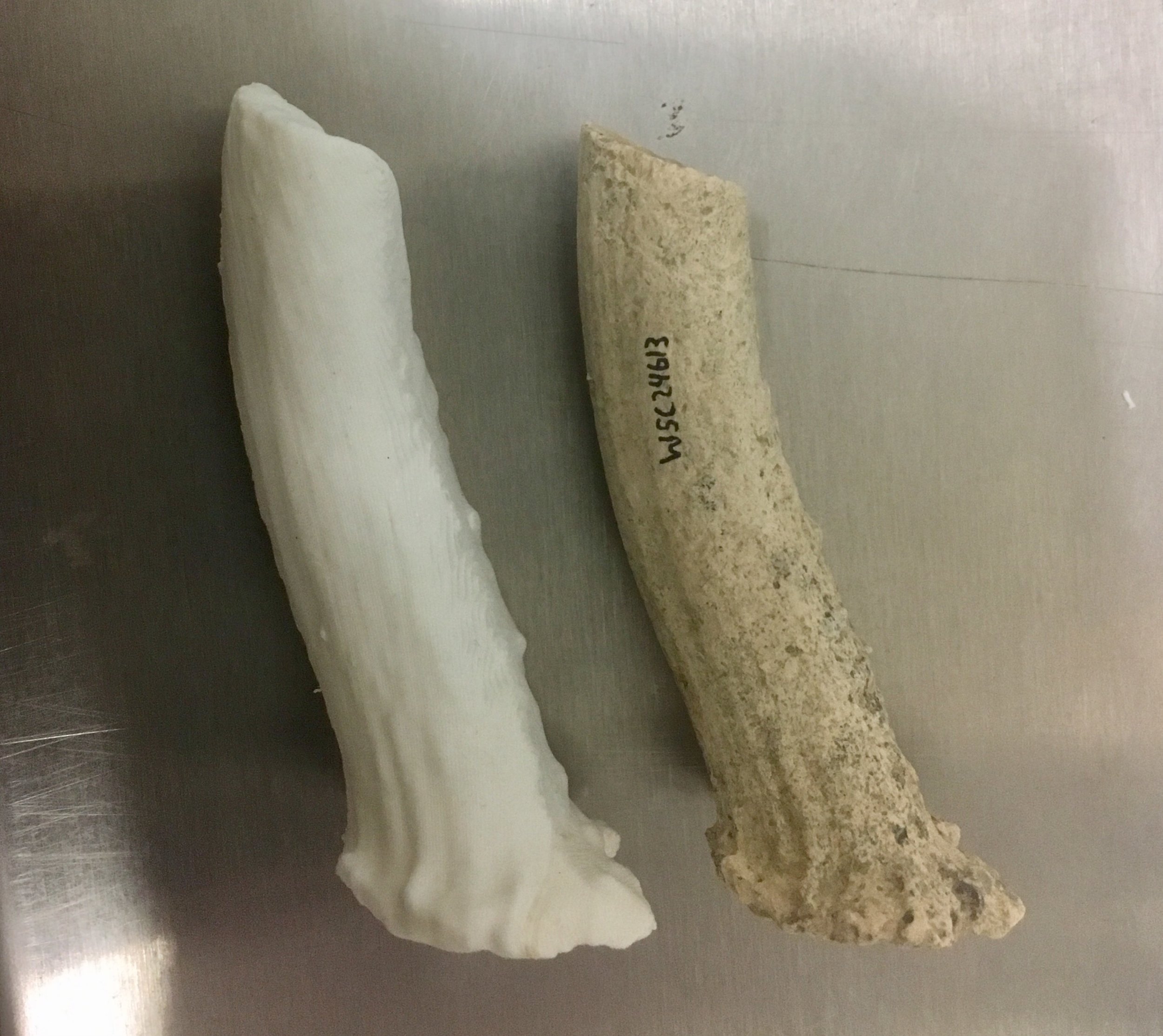 Over the last few weeks we’ve been continuing both our studies of the collection of Pleistocene fossils from the Harveston neighborhood of Murrieta, as well as setting up and learning to use our new 3D scanning and printing capabilities. These two projects have rapidly started to come together. The specimen on the right is an antler from a small deer, consistent in size and shape with the white-tailed deer Odocoileus virginianus (that’s been the case with all our deer material from Harveston so far). Given the way this antler is preserved, it’s likely that it was a shed antler.On the left is a 3D print of the same antler. We’ve now printed out several fossils at WSC, but what makes this one unique is that it’s the first print based on a 3D image file that we produced in-house. Rather than being produced with a laser scanner, this file was generated using photogrammetry, using 70 different photos of the antler. We’re planning to use both laser scanning and photogrammetry to generate our 3D models.The model of the deer antler is available for viewing or download on Sketchfab.
Over the last few weeks we’ve been continuing both our studies of the collection of Pleistocene fossils from the Harveston neighborhood of Murrieta, as well as setting up and learning to use our new 3D scanning and printing capabilities. These two projects have rapidly started to come together. The specimen on the right is an antler from a small deer, consistent in size and shape with the white-tailed deer Odocoileus virginianus (that’s been the case with all our deer material from Harveston so far). Given the way this antler is preserved, it’s likely that it was a shed antler.On the left is a 3D print of the same antler. We’ve now printed out several fossils at WSC, but what makes this one unique is that it’s the first print based on a 3D image file that we produced in-house. Rather than being produced with a laser scanner, this file was generated using photogrammetry, using 70 different photos of the antler. We’re planning to use both laser scanning and photogrammetry to generate our 3D models.The model of the deer antler is available for viewing or download on Sketchfab.
Fossil Friday - printed bison calcaneum
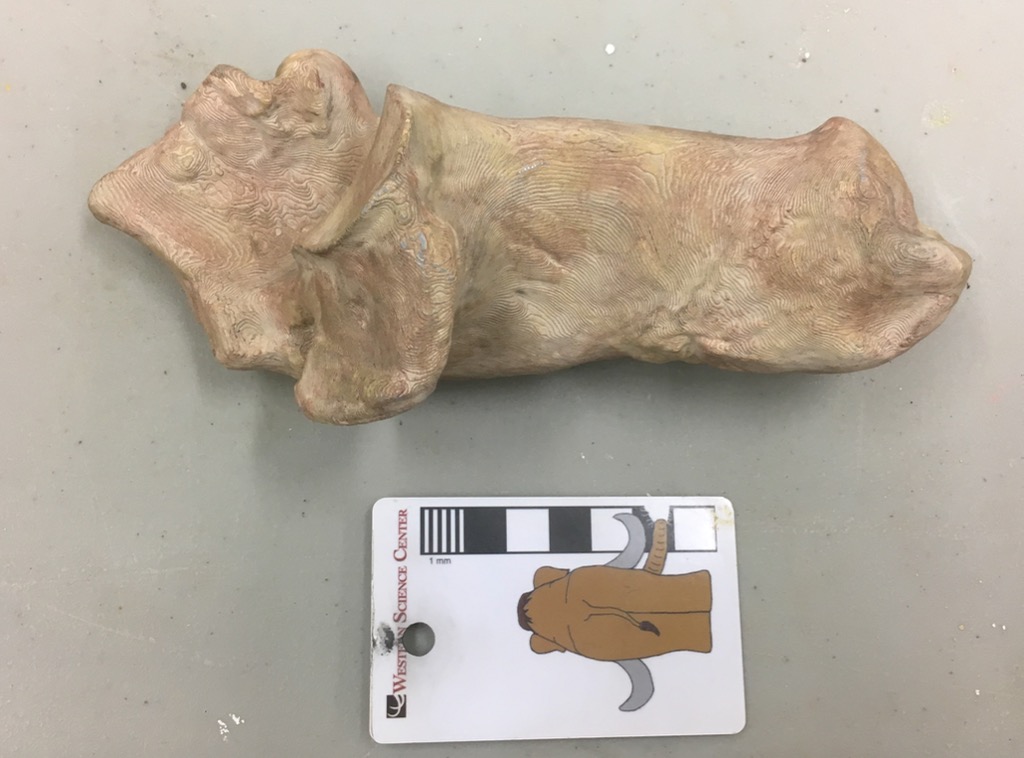 At our annual Science Under the Stars fundraiser last September, or donors provided us with funding to start a #D scanning and printing lab the the Western Science Center. While some of our equipment is still on order, our first printer arrived a few weeks ago and we've been printing as much as possible while we train ourselves in its use. During the Valley of the Mastodons Symposium, Bernard Means from the Virtual Curation Lab scanned a number of our specimens. While we wait for our scanner to arrive we've been printing some of Bernard's scans.Earlier this week we printed a right Bison calcaneum, seen above in medial view. The original specimen is exhibited in the floor case with the mastodon "Little Stevie" (they were found together). It's difficult to photograph through this case (below), and it's difficult to open; the symposium is the first time it has been opened in 11 years! So while the case was opened we scanned as much as possible, including this calcaneum (which is visible in the center of the case photo below):
At our annual Science Under the Stars fundraiser last September, or donors provided us with funding to start a #D scanning and printing lab the the Western Science Center. While some of our equipment is still on order, our first printer arrived a few weeks ago and we've been printing as much as possible while we train ourselves in its use. During the Valley of the Mastodons Symposium, Bernard Means from the Virtual Curation Lab scanned a number of our specimens. While we wait for our scanner to arrive we've been printing some of Bernard's scans.Earlier this week we printed a right Bison calcaneum, seen above in medial view. The original specimen is exhibited in the floor case with the mastodon "Little Stevie" (they were found together). It's difficult to photograph through this case (below), and it's difficult to open; the symposium is the first time it has been opened in 11 years! So while the case was opened we scanned as much as possible, including this calcaneum (which is visible in the center of the case photo below):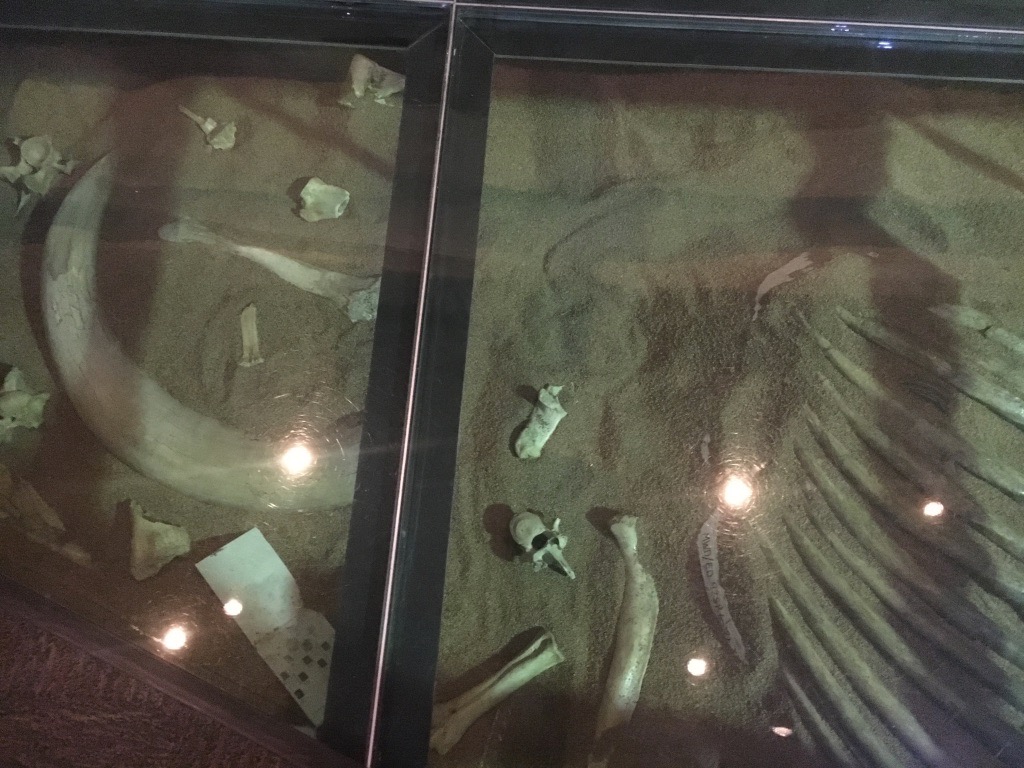 This bone was our largest single print to date, and took about 24 hours to print. We've since printed a slightly larger bone as we continue to explore the limits of the printer.
This bone was our largest single print to date, and took about 24 hours to print. We've since printed a slightly larger bone as we continue to explore the limits of the printer.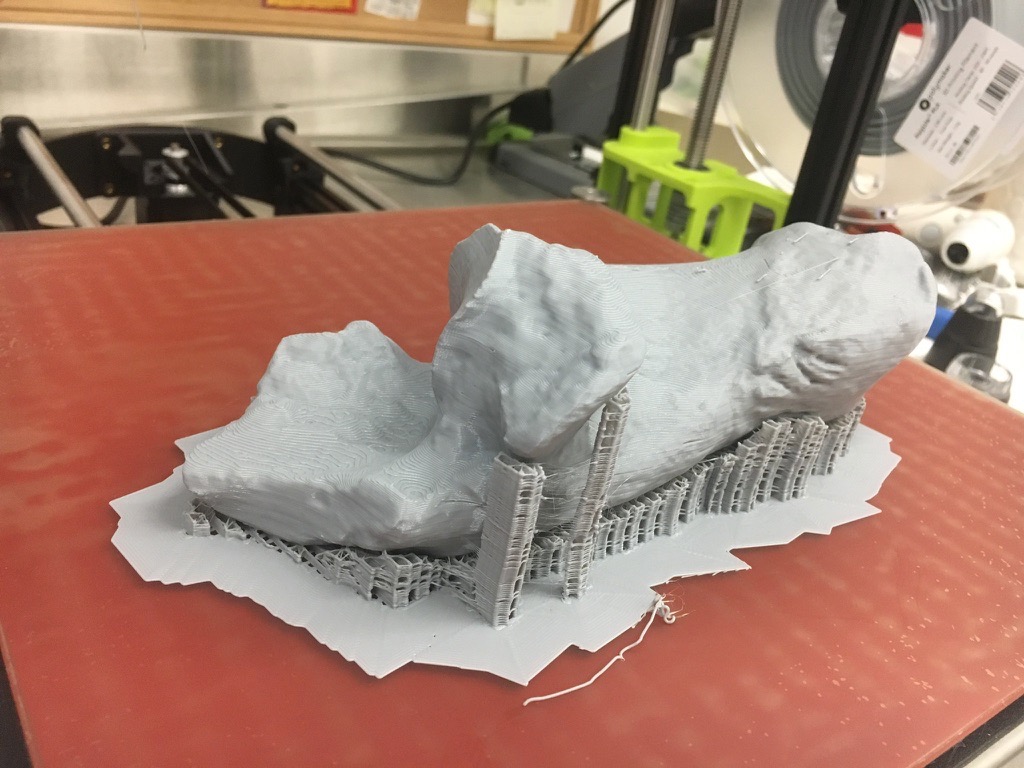 The calcaneum is part of the foot and ankle structure, and forms the heel and the attachment point for the Achilles tendon. This particular specimen was collected at Diamond Valley Lake's East Dam, and is roughly 45,000 years old. The original specimen is now back on display in its floor case, while the printed replica will be added to our teaching collection.
The calcaneum is part of the foot and ankle structure, and forms the heel and the attachment point for the Achilles tendon. This particular specimen was collected at Diamond Valley Lake's East Dam, and is roughly 45,000 years old. The original specimen is now back on display in its floor case, while the printed replica will be added to our teaching collection.
Fossil Friday - printed mastodon molar
 Each September, Western Science Center holds an annual fundraiser called Science Under the Stars to raise funds for museum operations. At the end of the evening we often do a final “Special Ask” to raise dedicated funds for a particular project. This year, for the Special Ask we requested funds for a 3D-scanning, photogrammetry, and printing lab. Our donors, led by the Soboba Band of Luiseño Indians, came through in spectacular fashion.
Each September, Western Science Center holds an annual fundraiser called Science Under the Stars to raise funds for museum operations. At the end of the evening we often do a final “Special Ask” to raise dedicated funds for a particular project. This year, for the Special Ask we requested funds for a 3D-scanning, photogrammetry, and printing lab. Our donors, led by the Soboba Band of Luiseño Indians, came through in spectacular fashion.  Our first purchase for the lab, a LulzBot TAZ6 printer (above), arrived last week. After our initial demo print to make sure everything was working, our first specimen print was a mastodon tooth (of course). It was printed from a digitial file provided to us by VCU’s Virtual Curation Lab, courtesy of Bernard Means and Terrie Simmons-Ehrhardt, which was in turn based on CT scans provided by California Imaging and Diagnostics. The particular tooth is the lower right 3rd molar of a West Dam mastodon we refer to as The Outlier, so named because its 3rd molars are the widest ones known from California (although still narrower than the average m3 from the rest of the country).In a few weeks we’ll be purchasing our scanning and photogrammetry equipment, as well as additional printers, so you’ll be hearing a lot more about this in the months ahead. Next week I’m attending the Geological Society of America meeting, where Brett and I will be presenting on both the “Stepping Out of the Past” and the “Valley of the Mastodons” exhibits, and I’ll have updates from there as well.
Our first purchase for the lab, a LulzBot TAZ6 printer (above), arrived last week. After our initial demo print to make sure everything was working, our first specimen print was a mastodon tooth (of course). It was printed from a digitial file provided to us by VCU’s Virtual Curation Lab, courtesy of Bernard Means and Terrie Simmons-Ehrhardt, which was in turn based on CT scans provided by California Imaging and Diagnostics. The particular tooth is the lower right 3rd molar of a West Dam mastodon we refer to as The Outlier, so named because its 3rd molars are the widest ones known from California (although still narrower than the average m3 from the rest of the country).In a few weeks we’ll be purchasing our scanning and photogrammetry equipment, as well as additional printers, so you’ll be hearing a lot more about this in the months ahead. Next week I’m attending the Geological Society of America meeting, where Brett and I will be presenting on both the “Stepping Out of the Past” and the “Valley of the Mastodons” exhibits, and I’ll have updates from there as well.
3D models of WSC specimens
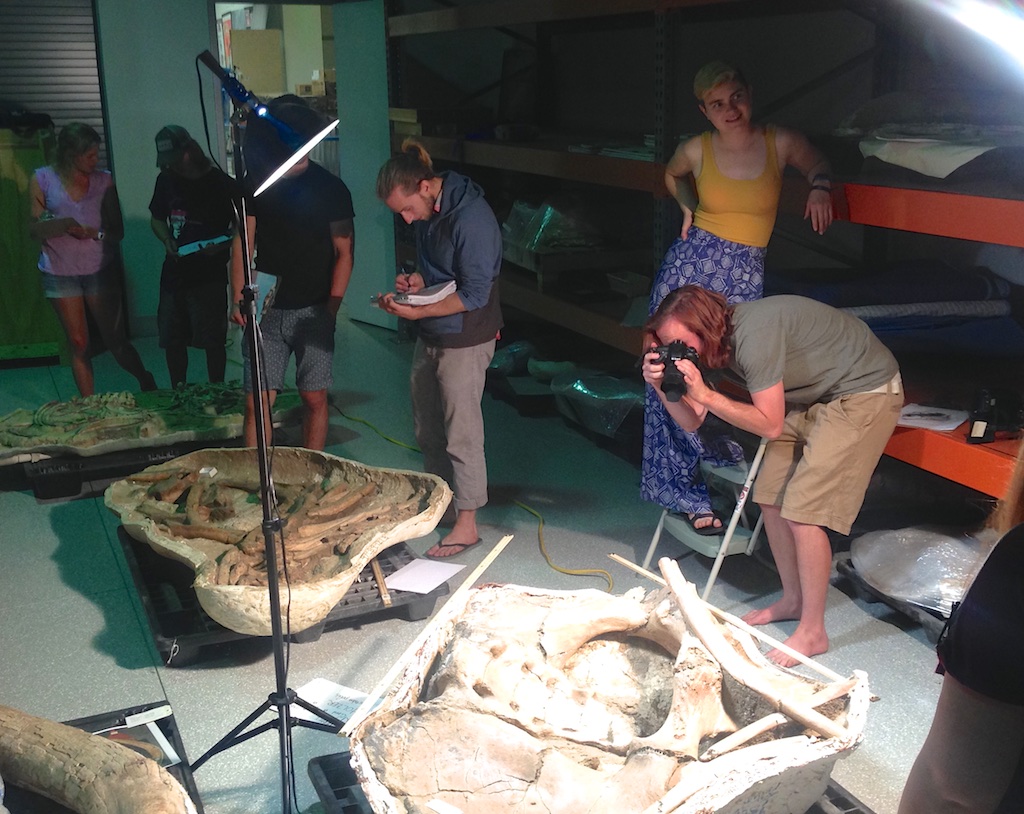 Last Saturday Pomona College's Karl Lang brought his geology class on a field trip to the Western Science Center, to learn about California's Pleistocene fauna and museum operations. While they were here, the students also took photos of several mastodon jackets in our collection in order to produce digital 3D models, which they've been kind enough to post online.Each image below has an embedded link to take you to a 3D viewer. Within the viewer, the images can be rotated and zoomed (I unfortunately couldn't get the viewer to embed properly in Wordpress).A partial vertebral column and ribcage:
Last Saturday Pomona College's Karl Lang brought his geology class on a field trip to the Western Science Center, to learn about California's Pleistocene fauna and museum operations. While they were here, the students also took photos of several mastodon jackets in our collection in order to produce digital 3D models, which they've been kind enough to post online.Each image below has an embedded link to take you to a 3D viewer. Within the viewer, the images can be rotated and zoomed (I unfortunately couldn't get the viewer to embed properly in Wordpress).A partial vertebral column and ribcage: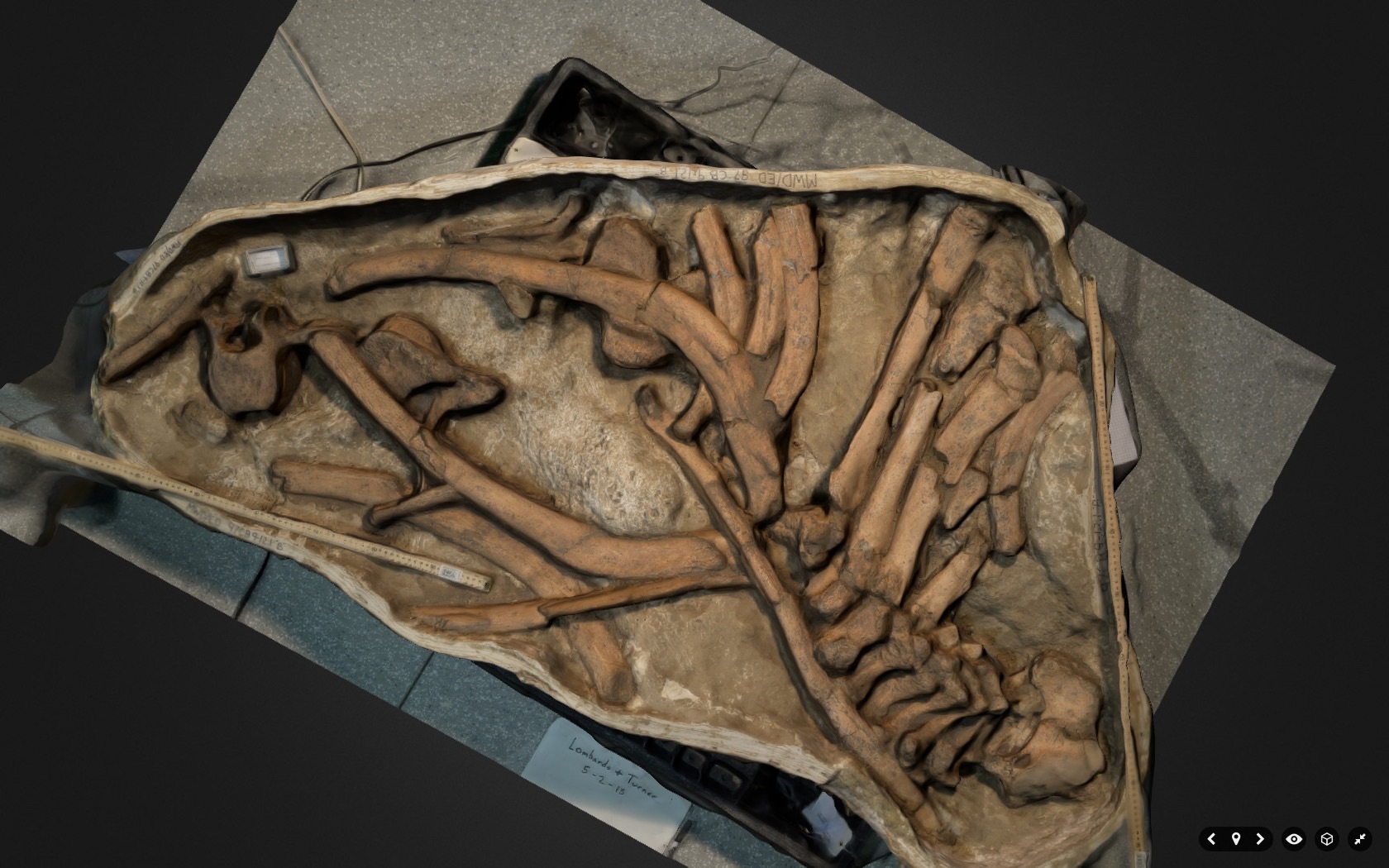 A pelvic girdle:
A pelvic girdle: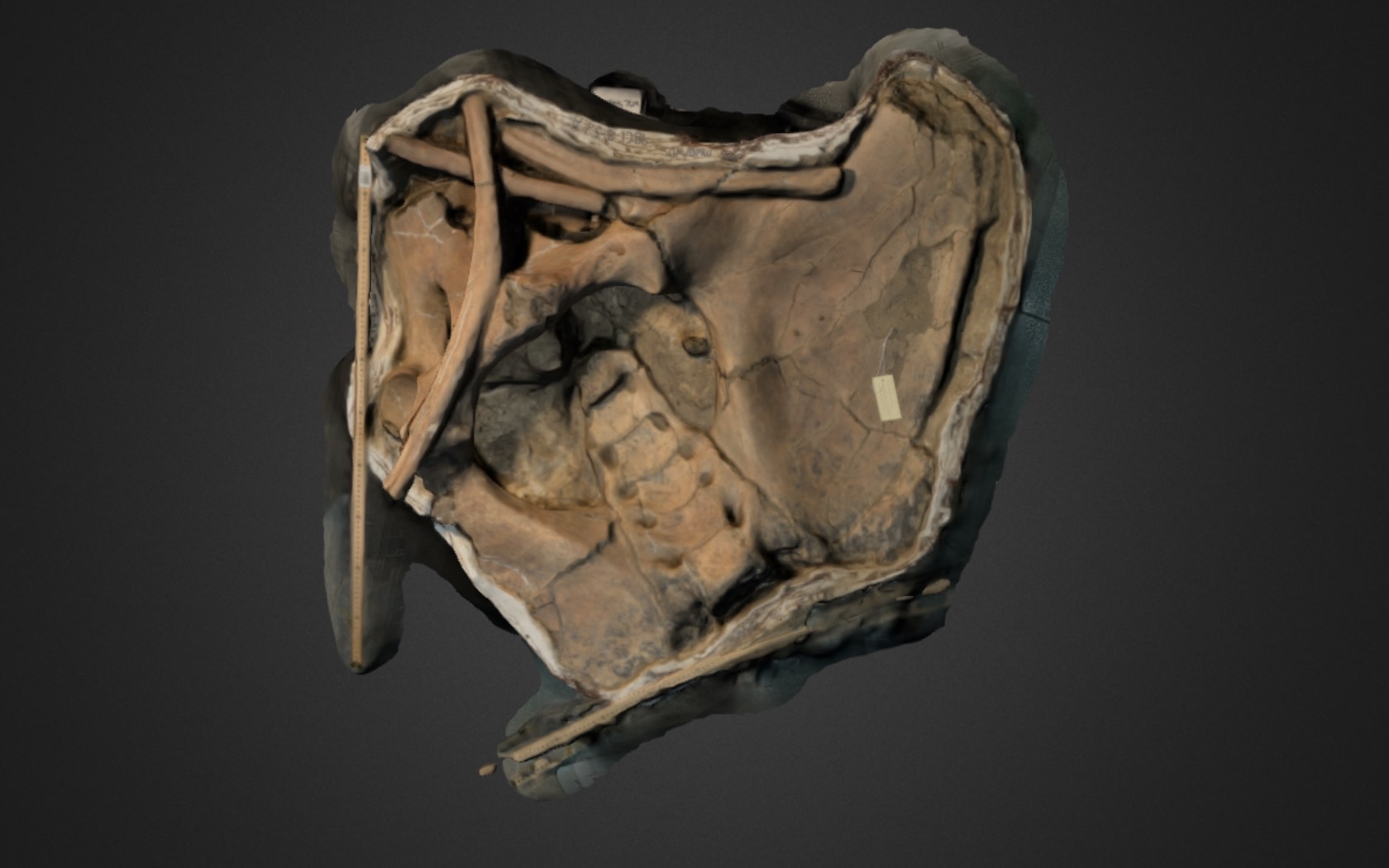 A partial skull:
A partial skull: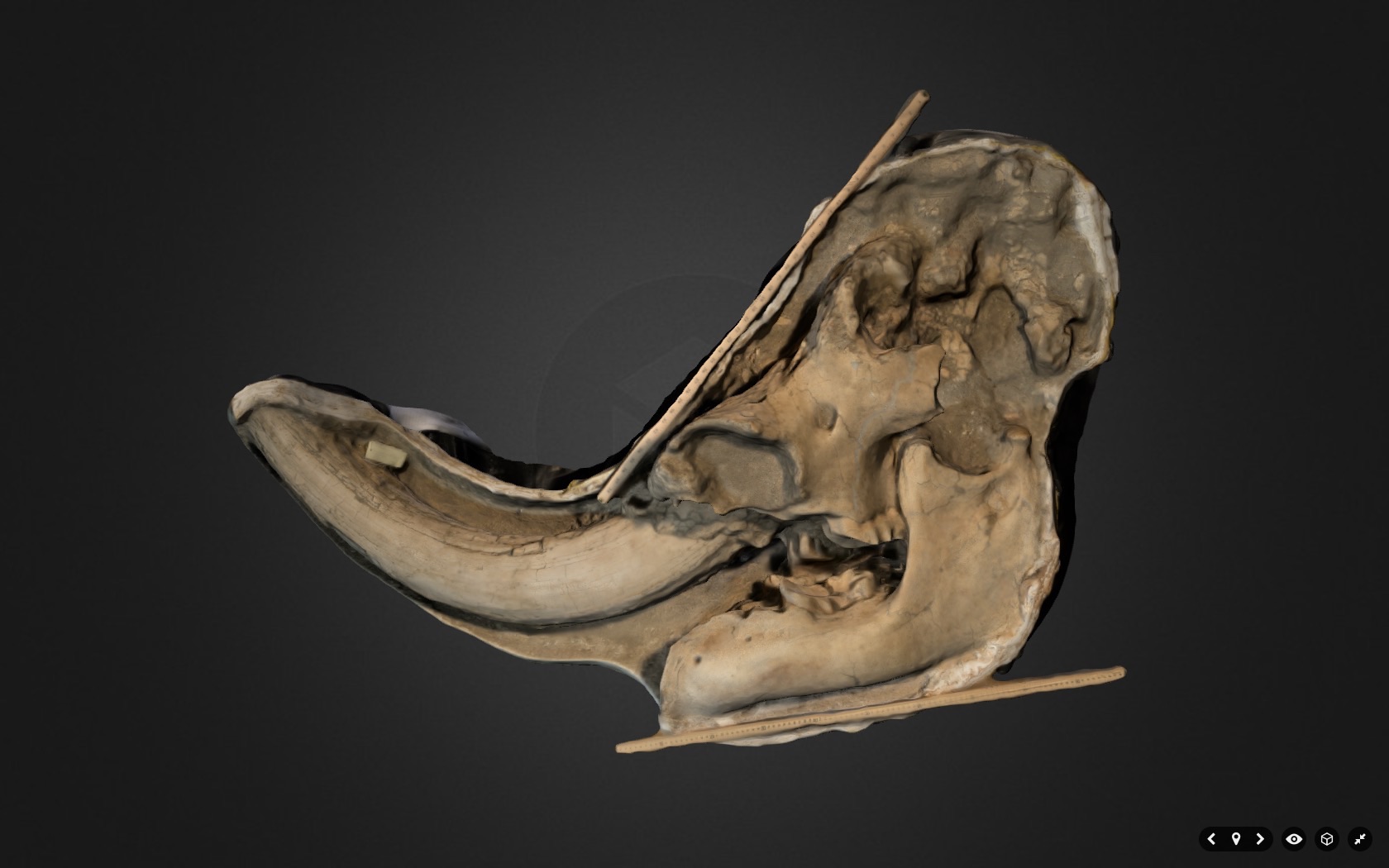 Thanks to Karl and Pamona's geology students for visiting, and for producing these great models!
Thanks to Karl and Pamona's geology students for visiting, and for producing these great models!
Casting program underway
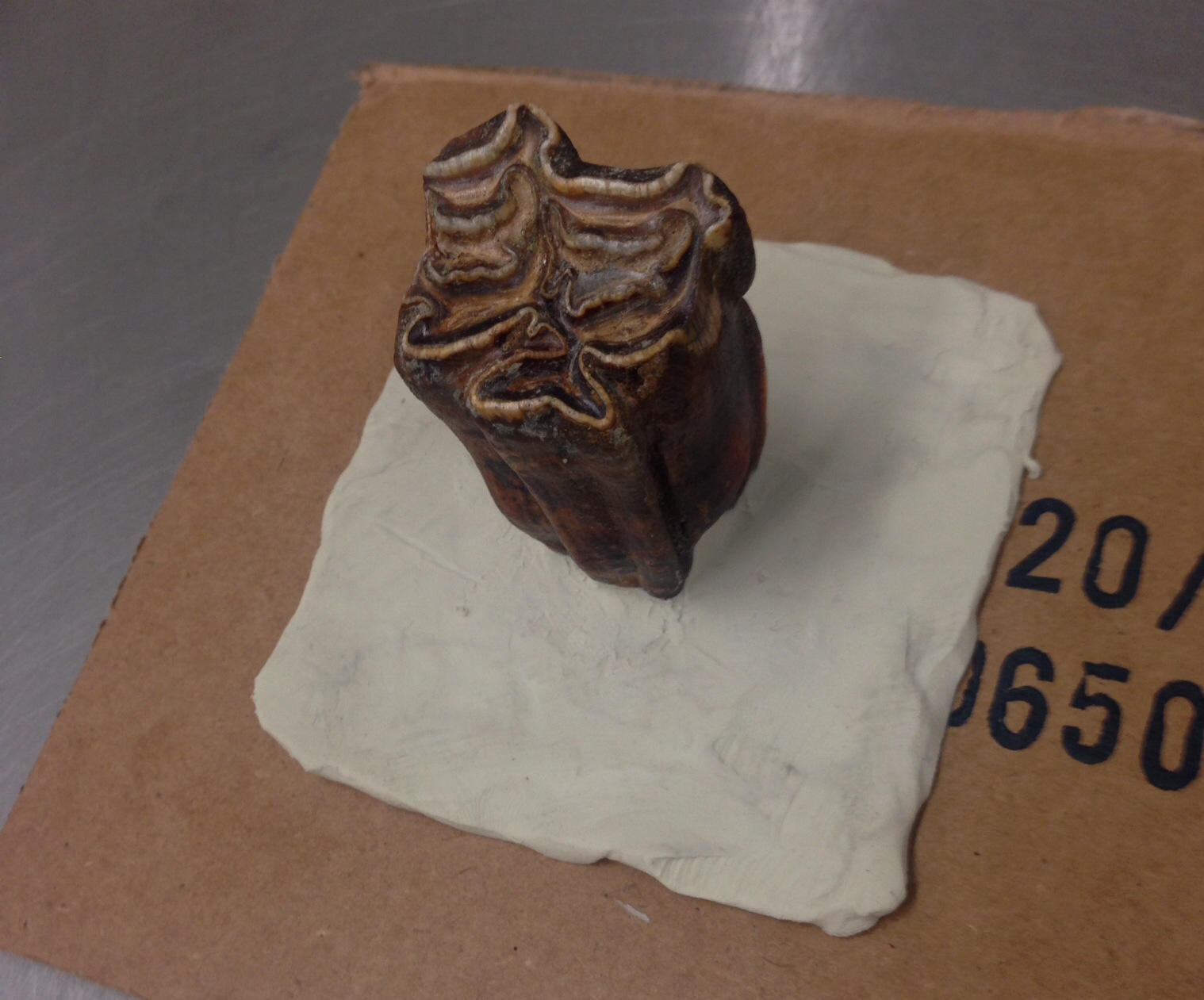 When I was at the Virginia Museum of Natural History, one of our most successful endeavors was an active molding and casting program to produce replicas of fossils in the VMNH collection. After moving to the Western Science Center one of my top priorities was to start a comparable program here, and I'm happy to report that our casting efforts are now underway.Since the WSC staff is still learning how to make molds, we chose some Pleistocene horse teeth for our first molds. These teeth are relatively tough and they have a pretty simple overall shape, so they stand up to molding well. After sealing cracks in the tooth and attaching it to a clay base (above), we built a box (made of either clay or, in this case, Legos) around the specimen:
When I was at the Virginia Museum of Natural History, one of our most successful endeavors was an active molding and casting program to produce replicas of fossils in the VMNH collection. After moving to the Western Science Center one of my top priorities was to start a comparable program here, and I'm happy to report that our casting efforts are now underway.Since the WSC staff is still learning how to make molds, we chose some Pleistocene horse teeth for our first molds. These teeth are relatively tough and they have a pretty simple overall shape, so they stand up to molding well. After sealing cracks in the tooth and attaching it to a clay base (above), we built a box (made of either clay or, in this case, Legos) around the specimen:
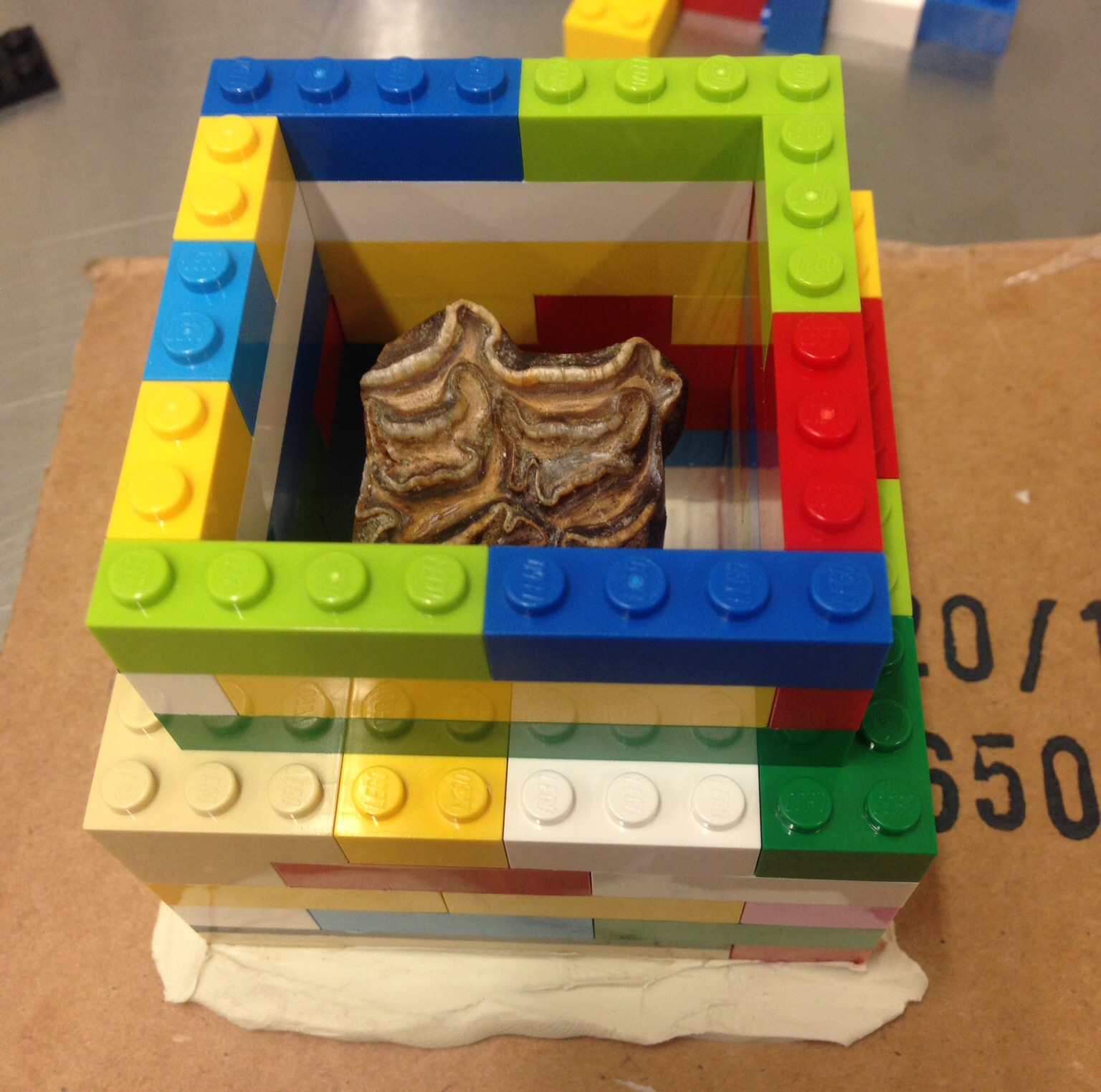 Once the box is built and sealed, we can pour liquid silicone over the specimen (being done here by our Collections Manager, Darla Radford):
Once the box is built and sealed, we can pour liquid silicone over the specimen (being done here by our Collections Manager, Darla Radford):
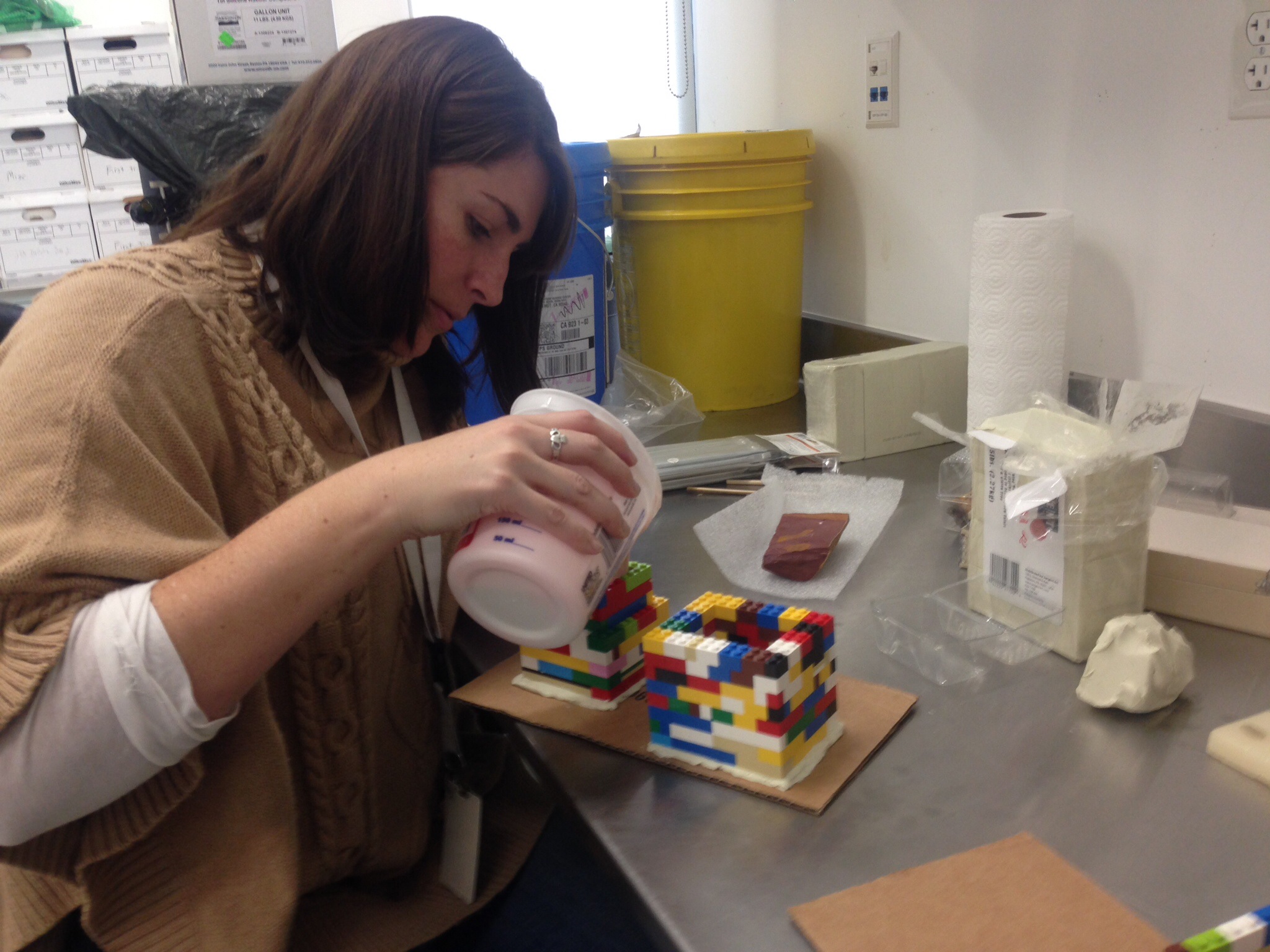 Once the silicone is cured, the fossil can be removed from the mold, and liquid resin can be mixed and poured in:
Once the silicone is cured, the fossil can be removed from the mold, and liquid resin can be mixed and poured in:
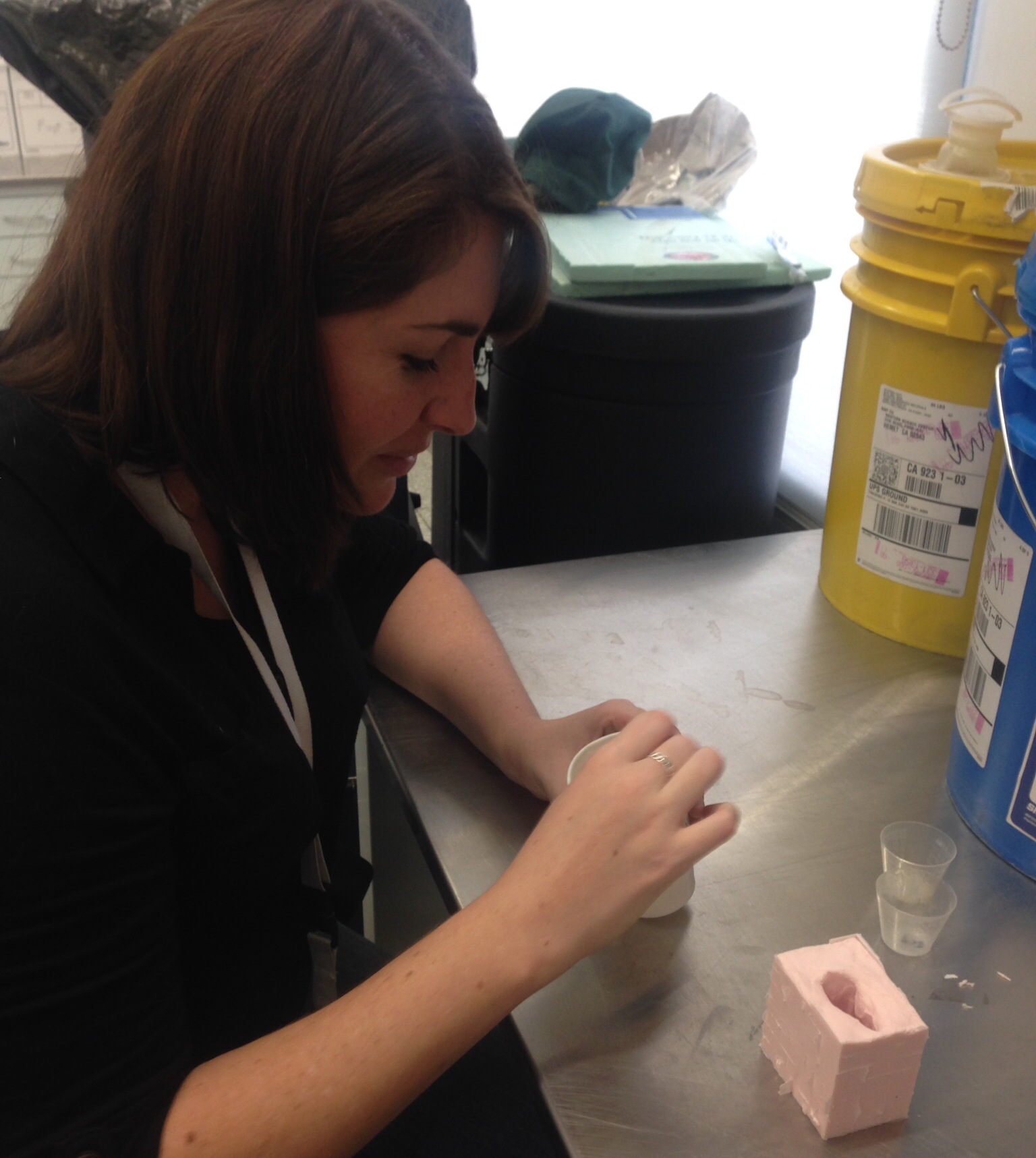 When the resin is cured, the resulting cast can be removed (two different horse teeth shown here):
When the resin is cured, the resulting cast can be removed (two different horse teeth shown here):
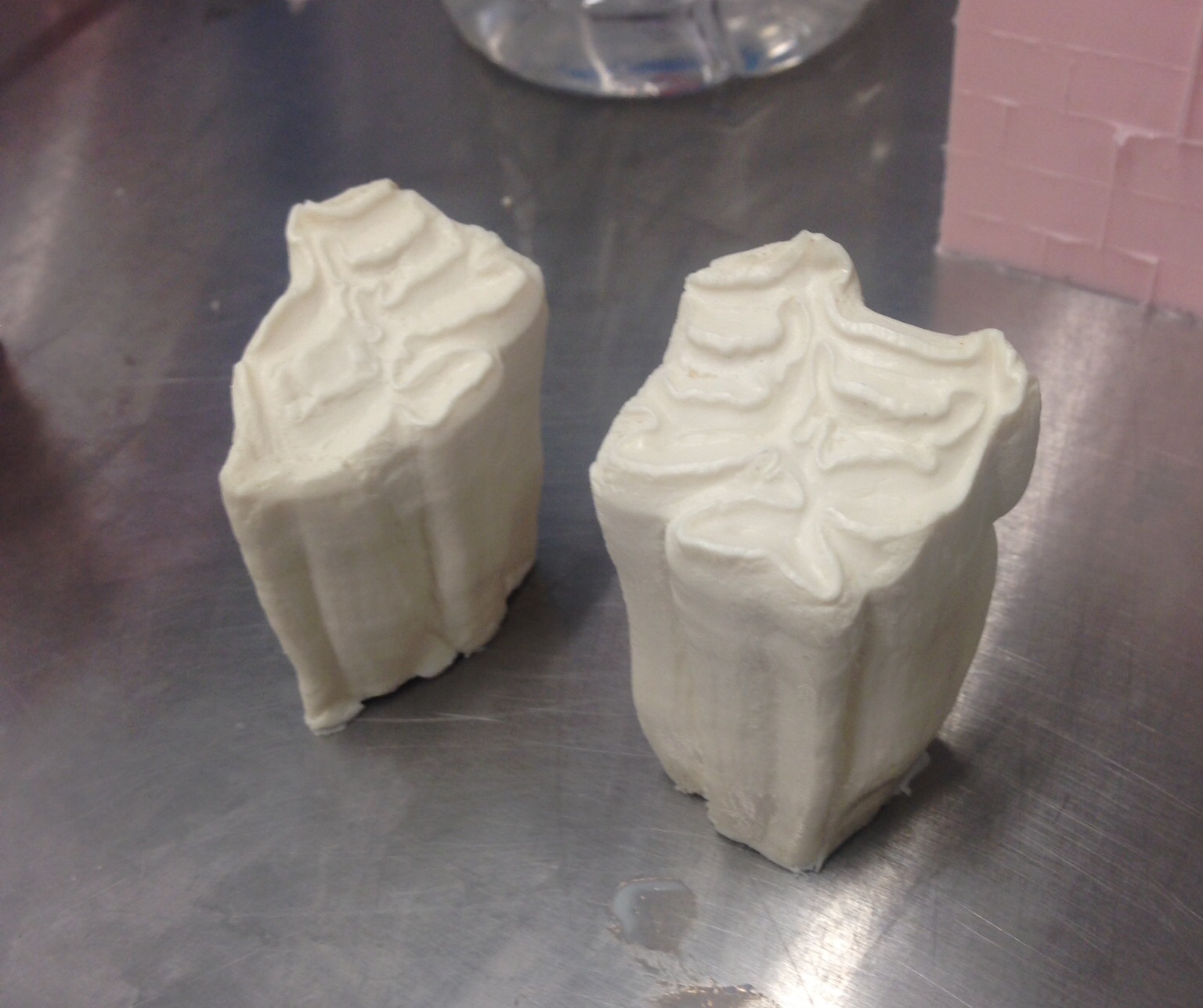 At this point the cast is ready for painting, to resemble the original fossil:
At this point the cast is ready for painting, to resemble the original fossil:
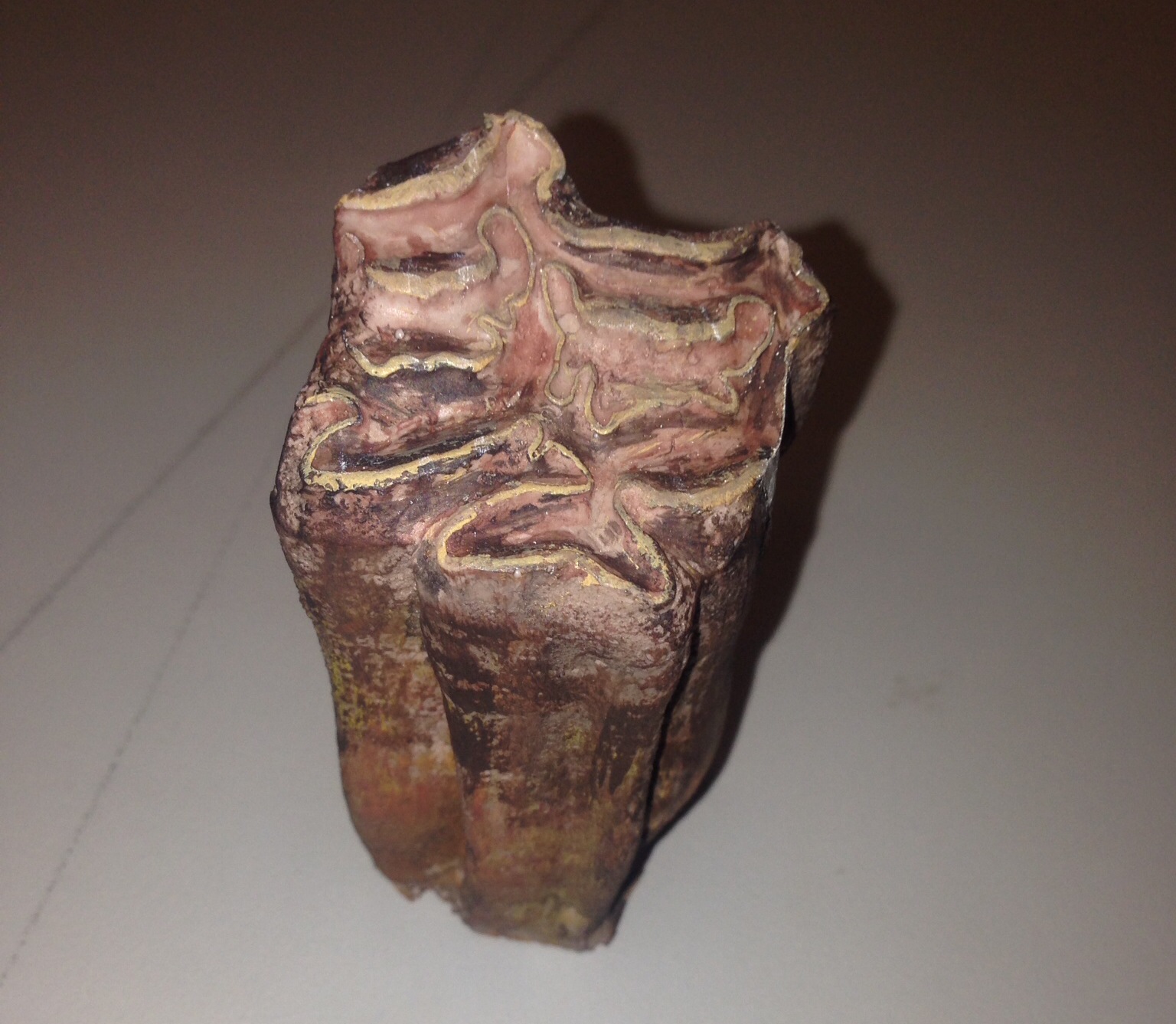 Establishing a casting program will greatly expand the things WSC can do with its collections in terms of exhibits and educational programs. Some of these hand-painted replicas will also be available in the museum's gift shop.
Establishing a casting program will greatly expand the things WSC can do with its collections in terms of exhibits and educational programs. Some of these hand-painted replicas will also be available in the museum's gift shop.

